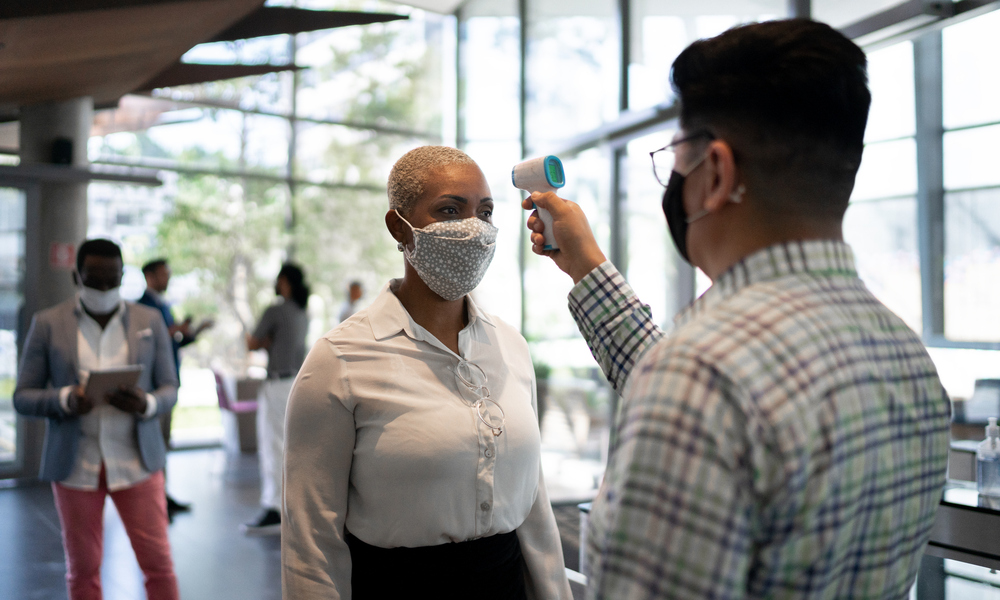
A Return to Meetings: COVID-19 Screening and Testing
When you resume your in-person meetings, should you conduct onsite screening and testing to avoid hosting a super-spreader event? Here's a look at what that may entail.
As meeting professionals look ahead to the eventual return to in-person events, safety is obviously top of mind. One question planners are likely asking is “Do we need to conduct onsite COVID-19 screening and testing?”
For a closer look at this, I spoke with Julie Ann Schmidt, CMM, CMP, a certified COVID compliance officer and founder and CEO of global events firm Lithium Logistics Group (who recently shared some details about digital contact tracing at conferences).
“Within the bucket of screening and testing, there are several things for planners to consider,” Schmidt said.
Before doing any type of screening or testing, consider having people sign and acknowledge that they are going to adhere to a code of conduct. “That can be done digitally when people register or when they arrive at registration,” she said.
That code may outline steps they need to take onsite, such as adhering to social-distancing protocols at the venue or wearing a mask. For a sample code of conduct, check out the one (registration required) included in the Accepted Practices Guide developed by the Events Industry Council.
Screening
For groups looking to go beyond a signed code of conduct, the next layer would be screening. “Really what you’re doing with this step is doing the best you can to keep someone who might have COVID out of your meeting,” Schmidt said.
The easiest, quickest, and most cost-effective way to do screening is to use a questionnaire, according to Schmidt. “It can be done with an app, or you can ask a person when they check in,” she said. “Questions would include, ‘Are you or anyone in your house awaiting a COVID test result? Have you been around anyone who’s tested positive in the past 14 days?’”
The frequency of screening is also something to consider. “You can do it only the first day, or you can do it every day, or you can even start it before arrival,” Schmidt said.
The next step beyond a questionnaire would be “checking to see if people have some other type of indicator that they could have COVID,” she said. “Not that they do but that they could.”
The most common way to do this next level of screening is taking a person’s temperature using an infrared, no-contact thermometer. “The CDC says 100.4 is a fever, so an association could decide anyone with that temperature or above does not get in the doors,” Schmidt said.
Or an association could say that anyone with a temperature of over 100 needs to go to secondary screening in a separate area. “That would likely involve re-asking those screening questions, retaking their temperature, and putting an oxygen meter on their finger and checking their oxygen levels,” she said. “Based on those results, you may decide to let them in or have them leave.”
To keep track of who was screened and allowed in, Schmidt recommends giving people wristbands that are a different color each day or putting stickers on name badges. “Both are quickly identifiable,” she said.
Testing
Onsite testing adds a layer of logistics and expense, but “a group may decide that the possibility of having someone get sick and being labeled as a ‘super-spreader event’ is not a risk they’re willing to take—and decide that it’s worth the investment to hire medical professionals to test everyone,” Schmidt said.
For example, she knows of one group that held an event in a warm location where attendees were given a rapid test outside on the first day before they could enter the venue. Then, on the days that followed, attendees filled out an app-based screening questionnaire and had their temperature taken.
“Right now, I see this much more in the corporate space, and the meetings doing it tend to be on the smaller side,” Schmidt said. “However, as more testing options at a lower price point become available, I can see testing become more common.”
Other Considerations
Whether an association decides to do screening, testing, or both, Schmidt said there needs to be a person onsite who is responsible for all the COVID stuff. “If you’re having everyone come in and be screened in some way, you need to have someone ready to help immediately if a problem arises,” she added.
In addition, since people are likely paying to attend your conference, you need to have a plan for a situation where you send a person away if they fail their screening or receive a positive test result. “Are you going to refund their full registration? Plus, what is the situation with the hotel? I think it’s worth asking hotels not to hit people who fail screening with a full cancellation,” Schmidt said.
Also, discuss with the hotel what happens if someone has to leave and it dips you below your attrition levels. “Ideally, you want them to waive those attendees out of your attrition tracking,” she said. “And the hotels I’ve talked to said that’s exactly what they’d do, because they don’t want anyone staying there who is sick.”
As people begin receiving the vaccine, associations may decide to change their procedures around COVID-19 screening and testing too.
“It’s constantly evolving,” Schmidt said. “But even with a vaccine, keep in mind that a lot will also depend on what protocols your attendees still want your association to have in place so they feel comfortable attending.”
This is the second piece of a three-part series about meetings post-COVID. In part one, I looked at how contact tracing works. And in part three, I’ll discuss COVID protocol documents that meeting professionals should put together.
(FG/E+/Getty Images Plus)






Comments